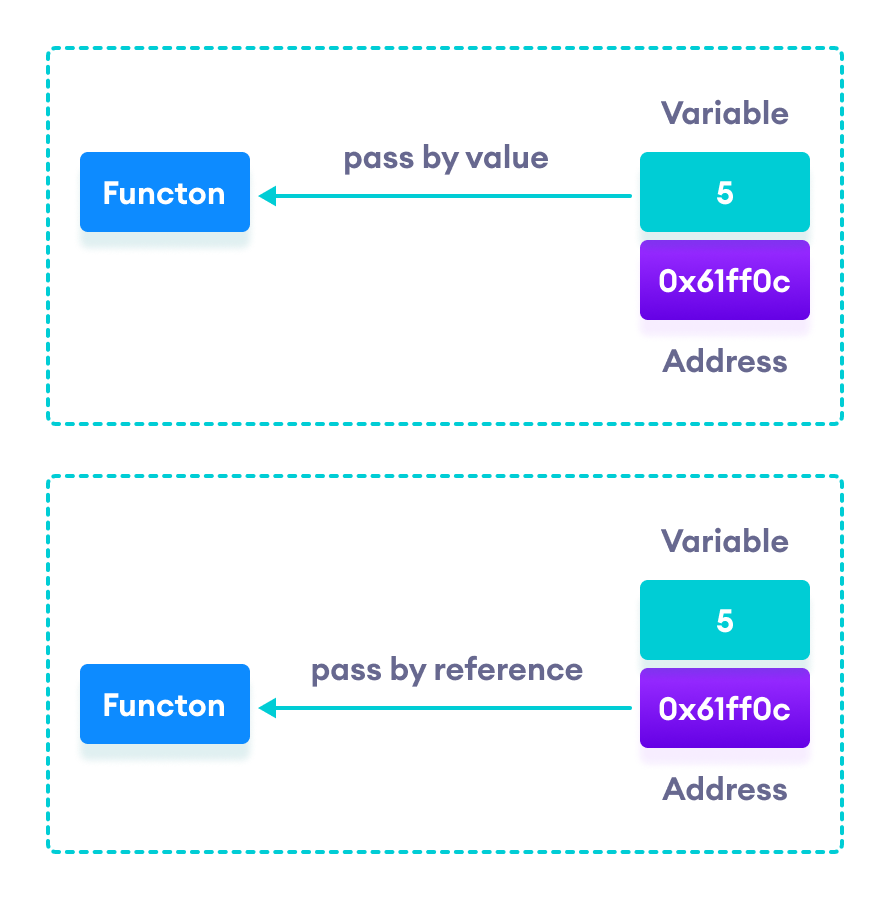📌 相关文章
- 通过引用调用 c++ 代码示例
- C++中的指针和引用(1)
- C++中的指针和引用
- C++引用与指针
- C++中的指针与引用
- C解引用指针
- C++中的指针与引用(1)
- C++中的指针与引用
- C++中的指针与引用(1)
- C解引用指针(1)
- c# 引用调用 - C# (1)
- c# 引用调用 - C# 代码示例
- 使用示例和应用程序引用C++中的指针
- 使用示例和应用程序引用C++中的指针(1)
- C/C++指针与Java引用
- CC++ 指针与Java引用(1)
- C/C++ 指针与Java引用
- CC++指针与Java引用(1)
- C++ 值调用和 引用调用
- C++ 值调用和 引用调用(1)
- 将引用转换为指针 c++ 代码示例
- 将引用转换为指针 c++ (1)
- C#函数 按引用调用
- 通过地址调用更有效的引用调用 (1)
- 通过地址调用更有效的引用调用 - 无论代码示例
- php函数-引用调用(1)
- php函数-引用调用
- 将引用传递给C++中的指针
- 将引用传递给C++中的指针
📜 通过引用进行C++调用:使用指针[包含示例]
📅 最后修改于: 2020-09-25 05:05:59 🧑 作者: Mango
在本教程中,我们将借助示例学习如何通过引用将指针作为函数的参数传递给C++调用。
在C++函数教程中,我们学习了有关将参数传递给函数。所使用的此方法称为“按值传递”,因为传递了实际值。
然而,参数传递到参数的实际值不会传递函数的另一种方式。而是传递对值的引用。
例如,
// function that takes value as parameter
void func1(int numVal) {
// code
}
// function that takes reference as parameter
// notice the & before the parameter
void func2(int &numRef) {
// code
}
int main() {
int num = 5;
// pass by value
func1(num);
// pass by reference
func2(num);
return 0;
}注意& in void func2(int &numRef) 。这表示我们正在使用变量的地址作为参数。
因此,当我们通过传递变量num作为参数在main()调用func2() 函数时,实际上是在传递num变量的地址而不是值5 。

示例1:不带指针的引用传递
#include
using namespace std;
// function definition to swap values
void swap(int &n1, int &n2) {
int temp;
temp = n1;
n1 = n2;
n2 = temp;
}
int main()
{
// initialize variables
int a = 1, b = 2;
cout << "Before swapping" << endl;
cout << "a = " << a << endl;
cout << "b = " << b << endl;
// call function to swap numbers
swap(a, b);
cout << "\nAfter swapping" << endl;
cout << "a = " << a << endl;
cout << "b = " << b << endl;
return 0;
} 输出
Before swapping
a = 1
b = 2
After swapping
a = 2
b = 1在此程序中,我们将变量a和b传递给swap() 函数。注意函数定义,
void swap(int &n1, int &n2)在这里,我们使用&表示该函数将接受地址作为其参数。
因此,编译器可以识别出变量的引用被传递给函数参数,而不是实际值。
在swap() 函数, 函数参数n1和n2分别指向与变量a和b相同的值。因此,交换发生在实际价值上。
使用指针可以完成相同的任务。要了解指针,请访问C++指针。
示例2:使用指针传递引用
#include
using namespace std;
// function prototype with pointer as parameters
void swap(int*, int*);
int main()
{
// initialize variables
int a = 1, b = 2;
cout << "Before swapping" << endl;
cout << "a = " << a << endl;
cout << "b = " << b << endl;
// call function by passing variable addresses
swap(&a, &b);
cout << "\nAfter swapping" << endl;
cout << "a = " << a << endl;
cout << "b = " << b << endl;
return 0;
}
// function definition to swap numbers
void swap(int* n1, int* n2) {
int temp;
temp = *n1;
*n1 = *n2;
*n2 = temp;
} 输出
Before swapping
a = 1
b = 2
After swapping
a = 2
b = 1在这里,我们可以看到输出与前面的示例相同。注意这一行,
// &a is address of a
// &b is address of b
swap(&a, &b);在此,变量的地址是在函数调用期间传递的,而不是在变量传递时传递的。
由于传递的是地址而不是值,因此必须使用解引用运算符 *来访问存储在该地址中的值。
temp = *n1;
*n1 = *n2;
*n2 = temp;
*n1和*n2给出存储在地址n1和n2的值。
由于n1和n2包含a和b的地址,因此对*n1和*n2做任何事情都会改变a和b的实际值。
因此,当我们在main() 函数打印a和b的值时,这些值会更改。